Moth guides go digital
If, like me, your specialist natural history subject lies away from Lepidoptera, you'll almost certainly find moths somewhat daunting — at least initially. In excess of 2,400 species have been recorded in Britain and this total continues to rise. Many species look extremely similar, even identical, to the untrained eye, and micro-moths are notorious for their ability to bewilder.
Since the turn of the millennium, much has been done to tackle moth identification head on. Rising from the ashes of old-school photo-guides illustrating pinned, faded specimens, a series of brilliant field guides has emerged in little over a decade. First came Waring, Townsend & Lewington's hotly anticipated Field Guide to the Moths of Great Britain and Ireland (published in 2004), pleasantly complemented by Chris Manley's British Moths and Butterflies: A Photographic Guide in late 2008 — this the first of its kind to illustrate British moths in an effective and realistic manner as the age of digital photography blossomed. In 2011 Sterling, Parsons & Lewington produced the Field Guide to the Micro-Moths of Great Britain and Ireland (2011). In 2015, a second edition of the Manley guide emerged, with 700 more species of micro-moth illustrated and many photographs of existing species updated.
In the 2010s, the conversion of natural history field guides to app form has become so well rehearsed to the point that it is arguably now a rite of passage. Such esteemed titles as the Collins Bird Guide and The Sibley Guide to Birds have made a seamless and well-documented transition from page to screen, but comparatively few people know that two of the finest field guides covering British moths have too.
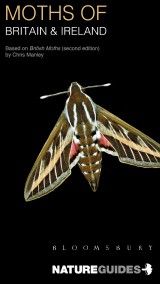 | 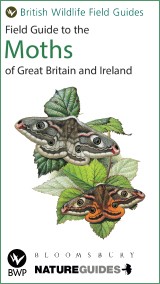 |
First released a few years back, the Moths of Britain and Ireland app was fully updated in December 2015 to reflect the second edition of the Manley guide released earlier in the year. Simultaneously came the major release of a combined app form of Waring, Townsend & Lewington's two tomes: the Field Guide to the Moths of Great Britain and Ireland app (though note that the illustrations from the Field Guide to the Micro-Moths of Great Britain and Ireland come as an additional in-app purchase). Both are formidable weapons for the digital-age moth-er: no longer is there a necessity to lug multiple books around when mothing, for all the same information can now be contained within just one iPhone (or iPad)...
The Field Guide to the Moths of Great Britain and Ireland app is a fine creation. Packed with the familiar brilliance of Richard Lewington's artwork, the app also includes all text from the books. Detailed species-by-species accounts include Field Characters, Similar Species, Flight Season, Life Cycle, Larval Foodplant, Habitat, and Status & Distribution sections plus range maps if available.
The app's format is pleasantly interactive. It's easy to swipe left and right between illustrations and text. The search function is slick and not too overcomplicated: you can search a species by name or scroll through a collapsible list of families. It's possible to order species either taxonomically or alphabetically, depending on preference. A symbol consisting of three overlapping rectangles, situated at the bottom of the app's home screen, allows the user to view each individual plate as it appears originally in the book — very useful for comparing similar species when confronted by a troubling moth and also offering an air of familiarity for those who prefer the book layout.
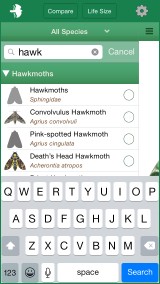 | 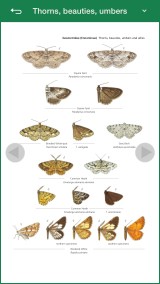 |
A compare function allows for two similar species to be analysed side-by-side. Choose the first species, then select 'Compare' to generate a list of similar species. I also enjoyed the life-size function — simply clicking the button converts Lewington's illustration to the real-life size, a very handy tool when trying to identify something drab and brown. It's also quite entertaining to gawp at just how small some of the micros are..!
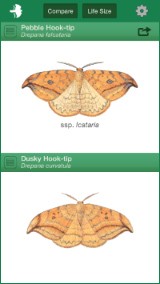 | 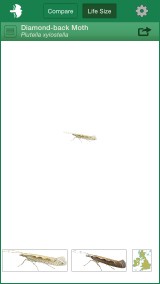 | 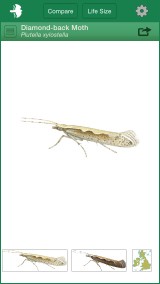 |
The structure, layout and format of the Moths of Britain and Ireland app (i.e. the Manley guide) is nigh on identical to that in The Field Guide to the Moths of Great Britain and Ireland app, minimising confusion when using one after the other. The primary difference of this app is that it uses photos, rather than illustrations, to depict the ~2,200 moth species covered within. The text is more fleeting and basic than in its counterpart, but it's the photo gallery which makes this app — this, incidentally, also includes all British butterflies.
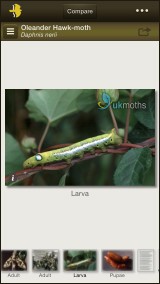 | 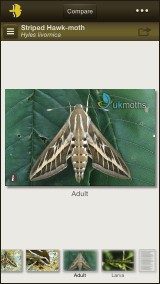 |
The truly outstanding feature of both apps is that they seamlessly link with each other, i.e. the tap of a single button switches apps (if the user has purchased both) to show the selected species in the corresponding title. The simplicity and ease of this is incomparable to the relative toil required to manually flick through two different field guides to find the same species and is a component that really encapsulates the overall advantageousness of app over hard copy.
For those possessing devices with smaller memory, it's worth noting that both apps are sizeable beasts. The Field Guide to the Moths of Great Britain and Ireland app weighs in at 902 MB while the Moths of Britain and Ireland app is a real monster at 1.96 GB. Nowadays most iPhones have ample storage but for those with slightly older models (such as myself — I have a 16 GB iPhone 5) the size could easily prove problematic and I had to delete a couple of other apps to make room for both. Another shortcoming, much to the chagrin of our Android readership, is that both apps are currently only available on iOS.
These two apps are fine productions in their own right. They are interactive and well designed, not overcomplicated and cluttered. Both work very well individually but the ability to switch directly between the two is a huge selling point and, when combined, makes them a quite impressive tool for the modern-day moth-er, from beginners to the most seasoned of enthusiasts.
To view and download either app, click on either of the icons below:
| The Field Guide to the Moths of Great Britain and Ireland app | Moths of Britain and Ireland app |
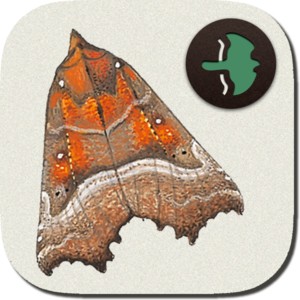 | 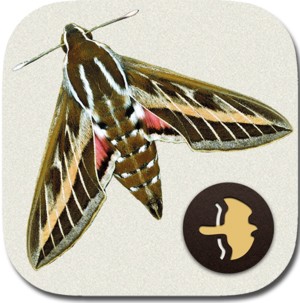 |



